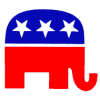Minnesota Republicans Look to End 10-Year Vote Skid in House Races in 2010
Votes for GOP House candidates statewide have gradually fallen each election cycle from 52 to 43 percent over the last ten years

The fact that Republicans in Minnesota, the Upper Midwest generally, and nationwide are optimistic for expected gains in the 2010 election cycle is incontrovertible.
However, to what extent Republicans will make gains in the Minnesota legislature remains an open question, and, unfortunately for the GOP, its ability to field candidates in legislative races has not been an indicator of success for its party at the ballot box in recent years.
Looking at general election races, Republicans have fielded a candidate in 98.3 percent of Minnesota House contests since 2002, or 527 of 536 races.
Despite doing so, they have seen their 82-seat caucus in 2002 fall to a narrow majority of 68 seats in 2004 and to minority status in 2006 (49 seats) and 2008 (47 seats).
Republicans failed to field a candidate in just five districts in 2002 (03A, 05A, 59A, 59B, 60B), one district in 2004 (03A) and three districts in 2006 (03B, 06A, 07B).
And despite pitting an opponent against the DFL in every district in 2008, the GOP notched its lowest percentage of statewide votes cast for House candidates in the past two decades (43.8 percent statewide).
In fact, Republicans have faced a declining amount of popular vote support in State House races dating back to 1998:
· In the 1998 election, when the GOP regained control of the House with victories in 71 districts, Republican candidates netted 52.2 percent of the votes in such races statewide.
· In 2000, winning 69 seats, Republicans won 51.4 percent of the vote.
· In 2002, the GOP won a plurality 49.1 percent of the vote statewide in House races.
· In 2004, only 47.0 percent of Minnesota voters cast their ballots for Republicans in House contests.
· In 2006, Republicans notched just 44.4 percent of the vote as they lost their majority party status.
· In 2008, only 43.8 percent of the vote went to GOP candidates in House races.
The Republican Party has also faced an increasingly problematic ratio in recent years of votes received statewide per House seats won. In 2002, the GOP received 12,952 votes statewide on average for each House seat it carried in that year’s general election. In 2004, that number increased to 18,563, rising to 19,329 in 2006, and 25,766 in 2008, with Republicans netting fewer seats each cycle. (Elevated statewide turnout in presidential election years accounted for some of this change).
But fielding candidates alone is not enough for the GOP, due in part to the fact that the DFL has become equally adept at placing candidates on the ballot across the state’s 134 districts in their own right – turning many districts into battlegrounds this decade and thinning out Republican Party resources in the process.
In 2000, the DFL failed to field a candidate in 13 districts, compared to just 2 for the GOP.
During the next four election cycles after redistricting, from 2002-2008, the DFL fielded a candidate in all but five contests, or 99.1 percent of all general election races (531 of 536).
And that is perhaps why the Politics in Minnesota article’s main focus was on the fact that multiple Republican challengers are popping up in some DFL-controlled districts across the state.
The implication, properly drawn, is that those candidates who emerge from the nomination and/or primary process for the GOP will be stronger for having first faced an intra-party opponent, and thus improve the Party’s prospects in the general election.
Follow Smart Politics on Twitter.
